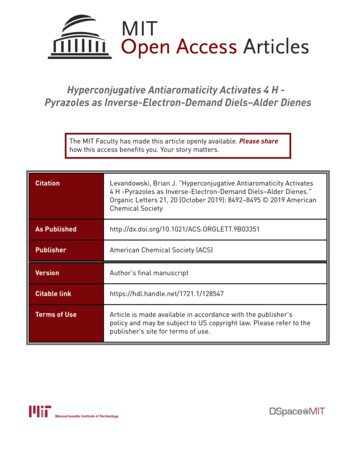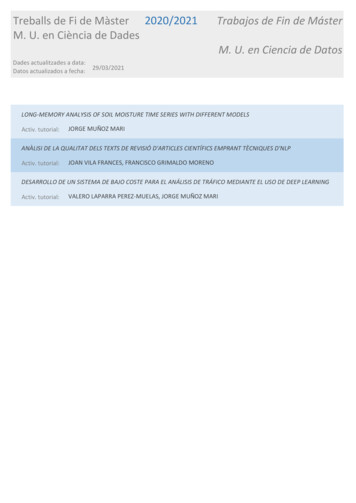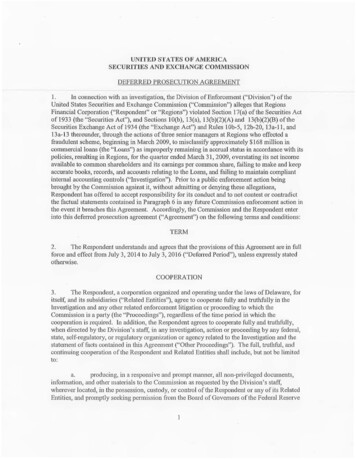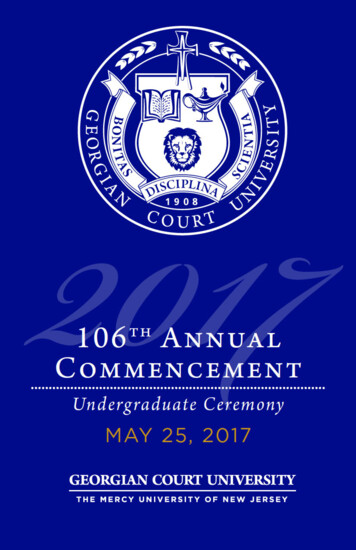
Transcription
Hyperconjugative Antiaromaticity Activates 4 H Pyrazoles as Inverse-Electron-Demand Diels–Alder DienesThe MIT Faculty has made this article openly available. Please sharehow this access benefits you. Your story matters.CitationLevandowski, Brian J. "Hyperconjugative Antiaromaticity Activates4 H -Pyrazoles as Inverse-Electron-Demand Diels–Alder Dienes."Organic Letters 21, 20 (October 2019): 8492–8495 2019 AmericanChemical SocietyAs 3351PublisherAmerican Chemical Society (ACS)VersionAuthor's final manuscriptCitable linkhttps://hdl.handle.net/1721.1/128547Terms of UseArticle is made available in accordance with the publisher'spolicy and may be subject to US copyright law. Please refer to thepublisher's site for terms of use.
HHS Public AccessAuthor manuscriptAuthor ManuscriptOrg Lett. Author manuscript; available in PMC 2020 February 12.Published in final edited form as:Org Lett. 2019 October 18; 21(20): 8492–8495. doi:10.1021/acs.orglett.9b03351.Hyperconjugative Antiaromaticity Activates 4H-Pyrazoles asInverse-Electron Demand Diels–Alder DienesBrian J. Levandowski†,§,‡, Nile S. Abularrage†,‡, K. N. Houk*,§, Ronald T. Raines*,‡†Departmentof Chemistry, Massachusetts Institute of Technology, Cambridge, Massachusetts02139, United StatesAuthor Manuscript§Departmentof Chemistry and Biochemistry, University of California, Los Angeles, California90095, United StatesAbstractThe Diels–Alder reactivity of 4,4-difluoro-3,5-diphenyl-4H-pyrazole (DFP) was investigatedexperimentally and computationally with endo-bicyclo[6.1.0]non-4-yne (BCN). Thecomputationally predicted rate enhancement from hyperconjugative antiaromaticity induced byfluorination of cyclopentadienes at the 5-position extends to 5-membered heterocyclic dienescontaining a saturated center. 4,4-Difluoro-4H-pyrazoles are new electron-deficient dienes withrapid reactivities towards strained alkynes.Graphical AbstractAuthor ManuscriptAuthor ManuscriptCyclopentadienes have been explored as a new class of bioorthogonal dienes with rapidreactivities and robust biological stabilities.1 Tetrachlorocyclopentadiene ketal (TCK) doesnot dimerize2 and can be synthesized in one step from readily available starting materials.As an ambiphilic diene, TCK reacts with both electron-deficient and electron-richdienophiles, and is stable towards biological nucleophiles. The rate constant for the Diels–Alder reaction of TCK with endo-bicyclo[6.1.0]non-4-yne (BCN) at room temperature inmethanol is 0.26 M 1s 1. TCK cycloadditions are as fast as the most rapid azide–alkynecycloadditions,3 but slower than the inverse-electron demand Diels–Alder reactions of 3,6diphenyl- and 3,6-dipyridyl-1,2,4,5-tetrazines with BCN, which have rate constants inMeOH at room temperature of 3.3 and 44.8M 1s 1, respectively.4The rapid Diels–Alder reactivity of cyclopentadienes is the result of the minimal distortionof the cyclopentadiene ground-state geometry required to achieve the transition-state*Corresponding Authors: houk@chem.ucla.edu (K.N.H.); rtraines@mit.edu (R.T.R.).‡B.J.L. and N.S.A. contributed equally to this work.Supporting InformationTables S1 and S2; Figure S1; computational methods and additional computational data, Cartesian coordinates, and energies; andsynthetic methods and analytical data (PDF)We declare no competing financial interests.
Levandowski et al.Page 2Author Manuscriptgeometry.5 The Diels–Alder reactivities of cyclopentadienes can be tuned by substitution atthe 5-position.6 Negative hyperconjugation at the saturated center of a cyclopentadieneenhances the Diels–Alder reactivity of the diene by producing antiaromatic 4π-electrondestabilization.7 This destabilization, which is especially strong when a fluoro group is thesubstituent, attracted our attention to the 4,4-difluoro-4H-pyrazole scaffold. Hünig8 andAdam9 have studied the Diels–Alder reactions of 3,5-dimethyl- and 3,5-diaryl-substituted4,4-dimethyl-4H-pyrazoles extensively and found that acid catalysis is needed to promotethe reaction, even with highly strained and electron-rich dienophiles. As shown in Scheme 1,the Diels–Alder reaction of 4,4-dimethyl-3,5-dimethyl-4H-pyrazole with cyclopentadiene(Cp) proceeds only in the presence of an acid catalyst.8a Though Diels–Alder reactions of4,4-difluoro-4H-pyrazoles have yet to be studied, the destabilizing effects ofhyperconjugative antiaromaticity invoked by the geminal fluoro groups suggest that 4,4difluoro-4H-pyrazoles would be highly reactive as Diels–Alder dienes.Author ManuscriptWe have studied computationally and experimentally the Diels–Alder reactivity of 4,4dimethyl-3,5-diphenyl-4H-pyrazole (DMP), 4,4-difluoro-3,5-diphenyl-4H-pyrazole (DFP),and 3,6-diphenyl-1,2,4,5-tetrazine (Tz) with BCN (Scheme 2). We find that fluorinesubstitution enhances the Diels–Alder reactivity of DFP, making it more reactive than Tztowards BCN.Author ManuscriptWe began by evaluating the aromaticity of the 4H-pyrazole scaffold by using nuclearindependent chemical shift (NICS)10 calculations. Our intent was to determine if thehyperconjugative aromaticity and antiaromaticity observed in cyclopentadienes extends to4H-pyrazoles. NICS(0) calculations measure the magnetic shielding at the center of the ringand have been shown to correlate well with the Diels–Alder reactivities of heteroaromaticazadienes.11 Negative NICS values are associated with a diatropic (aromatic) ring current,whereas positive NICS values are indicative of paratropic (antiaromatic) ring current. TheNICS(0) value of 0.5 ppm for the unsubstituted 4H-pyrazole suggests that the 4H-pyrazolescaffold is not aromatic (Table S1). Fluorination of the 4H-pyrazole leads to antiaromaticelectron delocalization (NICS(0) 6.2 ppm), whereas silylation induces aromatic electrondelocalization (NICS(0) 3.3 ppm).Author ManuscriptThe antiaromaticity of 4,4-difluoro-4H-pyrazoles led us to believe that they would be highlyreactive as inverse-electron demand Diels–Alder dienes. We computationally surveyed theDiels–Alder reactivities of DFP, DMP, and Tz towards BCN at the M06-2X/6-31G(d)//M06-2X/6-311 (d,p)-SMD(H2O) level of theory.12 Gas-phase energies are listed in TableS2. Our calculations reveal that fluorine substitution significantly enhances the reactivity ofthe 4H-pyrazole scaffold. The reaction of DFP with BCN is predicted to be 5.2 105 fasterand 12.5 kcal/mol more exergonic than the cycloaddition of DMP with BCN (Figure 1). Theincreased reactivity and exergonicity of the DFP cycloaddition are consistent with DFPbeing antiaromatic. The lowest unoccupied molecular orbital (LUMO) energies of DFP andDMP were calculated to be 2.1 and 1.3 eVs, respectively. The lowering of the LUMOresults in more favorable frontier molecular orbital interactions and is an additional factorthat contributes to the increased reactivity of DFP as an inverse-electron demand diene.Org Lett. Author manuscript; available in PMC 2020 February 12.
Levandowski et al.Page 3Author ManuscriptWe also compared the reactivity of the 4,4-difluoro-4H-pyrazole scaffold to the highlyreactive tetrazine scaffold. We found that the 4,4-difluoro-4H-pyrazole and tetrazinescaffolds have similar predicted reactivities towards BCN, with the computed activation freeenergies differing by only 0.1 kcal/mol in favor of DFP.Author ManuscriptWe synthesized DFP in one step and high yield (93%) from commercial starting materials bya route reported previously.13 To evaluate how the reactivity of the 4,4-difluoro-4H-pyrazolescaffold compares to that of the tetrazine scaffold, we measured pseudo-first-order kineticsfor the Diels–Alder reactions of DFP and Tz with BCN in 9:1 methanol/water at roomtemperature. A plot of the observed rate constants with respect to the BCN concentration isshown in Figure 2. The 4,4-difluoro-4H- pyrazole scaffold is more reactive than is thetetrazine scaffold towards BCN, with second-order rate constants of 5.2 M 1s 1 and 3.2 M 1s 1 for DFP and Tz, respectively. The rapid reactivity of DFP arises from the antiaromatic4π-electron delocalization invoked by negative hyperconjugation of the fluoro substituents.7To provide confirmation for hyperconjugative antiaromaticity as the source of the highreactivity of DFP, we stirred DMP with BCN; we detected no reaction after 2 h by NMRspectroscopy.To discern if hyperconjugative antiaromaticity compromises the stability of DFP in abiological context, we incubated DMP and DFP in phosphate-buffered saline (PBS)containing fetal bovine serum (FBS; 10% v/v) at 37 C. After 8 h, 42% of the DFP and 98%of the DMP remained intact (Figure S1). Thus, hyperconjugative antiaromaticity alsoincreases the reactivity of the diene towards biological nucleophiles, but not to substantialdetriment.Author ManuscriptThe DFP–BCN cycloadduct loses N2(g) spontaneously to yield a 5,5difluorocyclopentadiene product that we characterized by NMR spectroscopy and massspectrometry. The geminal fluoro groups at the saturated cyclopentadiene center of the 5,5difluorocyclopentadiene product induce hyperconjugative antiaromaticity.6 To see if thishyperconjugative antiaromaticity compromises stability, we incubated the cycloadduct inPBS containing FBS (10% v/v) at 37 C. After 8 h, no decomposition of the cycloadductwas apparent by UV-vis spectroscopy (Figure S1).In conclusion, we have experimentally confirmed the computationally predicted rateenhancing effects of hyperconjugative antiaromaticity on the Diels–Alder reactivity of 5membered cyclic dienes. The use of hyperconjugative antiaromaticity to tune the Diels–Alder reactivity of 5-membered cyclic dienes and 3-membered cyclic dienophiles14 will beuseful to click chemistry applications that require rapid and tunable kinetics.Author ManuscriptSupplementary MaterialRefer to Web version on PubMed Central for supplementary material.ACKNOWLEDGMENTSThis research was supported by Grants R01 GM044783 (NIH) and CHE-1764328 (NSF). Computational resourceswere provided by the UCLA Institute for Digital Research and Education (IDRE) and the Extreme Science andEngineering Discovery Environment (XSEDE),15 which is supported by Grant ACI-1548562 (NSF).Org Lett. Author manuscript; available in PMC 2020 February 12.
Levandowski et al.Page 4Author ManuscriptREFERENCESAuthor ManuscriptAuthor ManuscriptAuthor Manuscript(1). Levandowski BJ; Gamache RF; Murphy JM; Houk KN Readily Accessible AmbiphilicCyclopentadienes for Bioorthogonal Labeling. J. Am. Chem. Soc 2018, 140, 6426–6431.[PubMed: 29712423](2). (a)Eibler E; Burgemeister T; Höcht P; Prantl B; Roßmaier H; Schuhbauer HM; Wiest H; Sauer JPolyhalogenated Cyclopentadienes in [4 2] Cycloadditions: Preparative Aspects. Liebigs Ann.1997, 1997, 2451–2469.(b)Eibler E; Höcht P; Prantl B; Roßmaier H; Schuhbauer HM; Wiest H;Sauer J Transitions of Electron Demand in Pericyclic Reactions: Normal, Neutral, and InverseDiels–Alder Reactions of Polyhalogenated Cyclopentadienes. Liebigs Ann. 1997, 1997, 2471–2484.(3). Dommerholt J; Rutjes FPJT; van Delft FL Strain-Promoted 1,3-Dipolar Cycloaddition ofCycloalkynes and Organic Azides. Top. Curr. Chem 2016, 374, 16.(4). Chen W; Wang D; Dai C; Hamelberg D; Wang B Clicking 1,2,4,5-Tetrazine and Cyclooctyneswith Tunable Reaction Rates. Chem. Commun 2012, 48, 1736–1738.(5). Levandowski BJ; Houk KN Theoretical Analysis of Reactivity Patterns in Diels–Alder Reactionsof Cyclopentadiene, Cyclohexadiene, and Cycloheptadiene with Symmetrical andUnsymmetrical Dienophiles. Org. Lett 2015, 80, 3530–3537.(6). (a)Nyulászi L; Schleyer P.v. R. Hyperconjugative π-Aromaticity: How To Make CyclopentadieneAromatic. J. Am. Chem. Soc 1999, 121, 6872–6875.(b)Fernández I; Wu JI; von Ragué SchleyerP Substituent Effects on “Hyperconjugative” Aromaticity and Antiaromaticity in PlanarCyclopolyenes. Org. Lett 2013, 15, 2990–2993. [PubMed: 23724938](7). (a)Levandowski BJ; Zou L; Houk KN Schleyer hyperconjugative aromaticity and Diels–Alderreactivity of 5-substituted cyclopentadienes. J. Comput. Chem 2016, 37, 117–123. [PubMed:26444427] (b)Levandowski BJ; Zou L; Houk KN Hyperconjugative Aromaticity andAntiaromaticity Control the Reactivities and π-Facial Stereoselectivities of 5-SubstitutedCyclopentadiene Diels–Alder Cycloadditions. J. Org. Chem 2018, 83, 14658–14666. [PubMed:30395708](8). (a)Beck K; Höhn A; Hünig S; Prokschy F Azobrücken aus Azinen, I. Isopyrazole alselektronenarme Diene zur Synthese von 2,3-Diazabicyclo[2.2.1]heptenen. Chem. Ber 1984, 117,517–533.(b)Beck K; Hünig S; Klärner F-G; Kraft P; Artschwager‐Perl U Azobrücken ausAzinen, VII. Diels–Alder-Reaktionen mit inversem Elektronenbedarf zwischen Isopyrazolen undCycloalkenen sowie Cycloalkadienen.—Ein Vergleich von Säure-Katalyse und Beschleunigungdurch Druck. Chem. Ber 1987, 120, 2041–2051.(9). (a)Adam W; Harrer HM; Nau WM; Peters K Electronic Substituent Effects on the Acid-Catalyzed[4 2] Cycloaddition of Isopyrazoles with Cyclopentadiene and the Photochemical andThermal Denitrogenation of the Resulting -2-ene Azoalkanes to Bicyclo[2.1.0]pentanes. J. Org. Chem 1994, 59,3786–3797.(b)Adam W; Ammon H; Nau WM; Peters K 4-Halo-4H-pyrazoles: Cycloadditionwith Cyclopentadiene to Azoalkanes of the 2,3-Diazabicyclo[2.2.1]hept-2-ene Type versusElectrophilic Addition with Cyclopentene. J. Org. Chem 1994, 59, 7067–7071.(10). (a)Chen Z; Wannere CS; Corminboeuf C; Puchta R; von Schleyer PR Nucleus-IndependentChemical Shifts (NICS) as an Aromaticity Criterion. Chem. Rev 2005, 105, 3842–3888.[PubMed: 16218569] (b)Fallah-Bagher-Shaidaei H; Wannere CS; Corminboeuf C; Puchta R; vonSchleyer PR Which NICS Aromaticity Index for Planar π Rings Is Best? Org. Lett 2006, 8, 863–866. [PubMed: 16494460] (c)Gershoni-Poranne R; Stanger A Magnetic Criteria of Aromaticity.Chem. Soc. Rev 2015, 44, 6597–6615. [PubMed: 26035305](11). Yang Y-F; Liang Y; Liu F; Houk KN Diels–Alder Reactivities of Benzene, Pyridine, and Di-,Tri-, and Tetrazines: The Roles of Geometrical Distortions and Orbital Interactions. J. Am.Chem. Soc 2016, 138, 1660–1667. [PubMed: 26804318](12). (a)Zhao Y; Truhlar DG The M06 Suite of Density Functionals for Main Group Thermochemistry,Thermochemical Kinetics, Noncovalent Interactions, Excited States, and Transition Elements:Two New Functionals and Systematic Testing of Four M06-class Functionals and 12 OtherFunctionals. Theor. Chem. Acc 2008, 120, 215–241.(b)Marenich AV; Cramer CJ; Truhlar DGUniversal Solvation Model Based on Solute Electron Density and on a Continuum Model of theOrg Lett. Author manuscript; available in PMC 2020 February 12.
Levandowski et al.Page 5Author ManuscriptSolvent Defined by the Bulk Dielectric Constant and Atomic Surface Tensions. J. Phys. Chem. B2009, 113, 6378–6396. [PubMed: 19366259](13). (a)Walton L; Duplain HR; Knapp AL; Eidell CK; Bacsa J; Stephens CE Synthesis and ChargeDensity Determination of 4,4-Difluoro-3,5-Diphenyl-4H-pyrazole and a Hydrate Derivative. J.Fluor. Chem 2015, 173, 12–17.(b)Breen JR; Sandford G; Patel B; Fray J Synthesis of 4,4Difluoro-1H-pyrazole Derivatives. Synlett 2015, 26, 51–54.(14). (a)Levandowski BJ; Houk KN Hyperconjugative, Secondary Orbital, Electrostatic, and StericEffects on the Reactivities and Endo and Exo Stereoselectivities of Cyclopropene Diels–AlderReactions. J. Am. Chem. Soc 2016, 138, 16731–16736. [PubMed: 27977194] (b)Ravasco JMJM;Monteiro CM; Trindade AF Cyclopropenes: A New Tool for the Study of Biological Systems.Org. Chem. Front 2017, 4, 1167–1198.(15). Towns J; Cockerill T; Dahan M; Foster I; Gaither K; Grimshaw A; Hazlewood V; Lathrop S;Lifka D; Peterson GD; Roskies R; Scott JR; Wilkins-Diehr N XSEDE: Accelerating ScientificDiscovery. Comput. Sci. Eng 2014, 16, 62–74.Author ManuscriptAuthor ManuscriptAuthor ManuscriptOrg Lett. Author manuscript; available in PMC 2020 February 12.
Levandowski et al.Page 6Author ManuscriptAuthor ManuscriptFigure 1.Transition-state geometries and calculated Gibbs free energies of activation (ΔG‡) andreaction (ΔGrxn) computed at the M06-2X/6-31G(d)//M06-2X/6-311 G(d,p)-SMD(H2O)level of theory for the Diels–Alder reactions of 4,4-dimethyl-3,5-diphenyl-4H-pyrazole(DMP), 4,4-difluoro-3,5-diphenyl-4H-pyrazole (DFP), and 3,6-diphenyl-1,2,4,5-tetrazine(Tz) towards BCN. The lengths (Å) of forming bonds are shown. Values of krel werecalculated at 298 K with the Arrhenius equation.Author ManuscriptAuthor ManuscriptOrg Lett. Author manuscript; available in PMC 2020 February 12.
Levandowski et al.Page 7Author ManuscriptAuthor ManuscriptFigure 2.Reaction of BCN (1, 5, or 10 mM) with DFP (0.1 mM) or Tz (0.1 mM) in 9:1 methanol/water. Values of kobs are the mean SEM for reactions performed in triplicate. Second-orderrate constants as calculated from a linear fit of the data were k2 5.2 M 1s 1 for DFP (R2 0.97), and k2 3.2 M 1s 1 for Tz (R2 0.99).Author ManuscriptAuthor ManuscriptOrg Lett. Author manuscript; available in PMC 2020 February 12.
Levandowski et al.Page 8Author ManuscriptAuthor ManuscriptScheme 1.The Diels–Alder reaction of 4,4-dimethyl-3,5-diphenyl-4H-pyrazole and cyclopentadiene(Cp) with or without an acid catalyst.9Author ManuscriptAuthor ManuscriptOrg Lett. Author manuscript; available in PMC 2020 February 12.
Levandowski et al.Page 9Author ManuscriptScheme 2.Author ManuscriptStructures of 4,4-dimethyl-3,5-diphenyl-4H-pyrazole (DMP), 4,4-difluoro-3,5-diphenyl-4Hpyrazole (DFP), 3,6-diphenyl-1,2,4,5-tetrazine (Tz), and endo-bicyclo[6.1.0]non-4-yne(BCN).Author ManuscriptAuthor ManuscriptOrg Lett. Author manuscript; available in PMC 2020 February 12.
§Department of Chemistry and Biochemistry, University of California, Los Angeles, California 90095, United States Abstract The Diels-Alder reactivity of 4,4-difluoro-3,5-diphenyl-4H-pyrazole (DFP) was investigated experimentally and computationally with endo-bicyclo[6.1.0]non-4-yne (BCN). The










